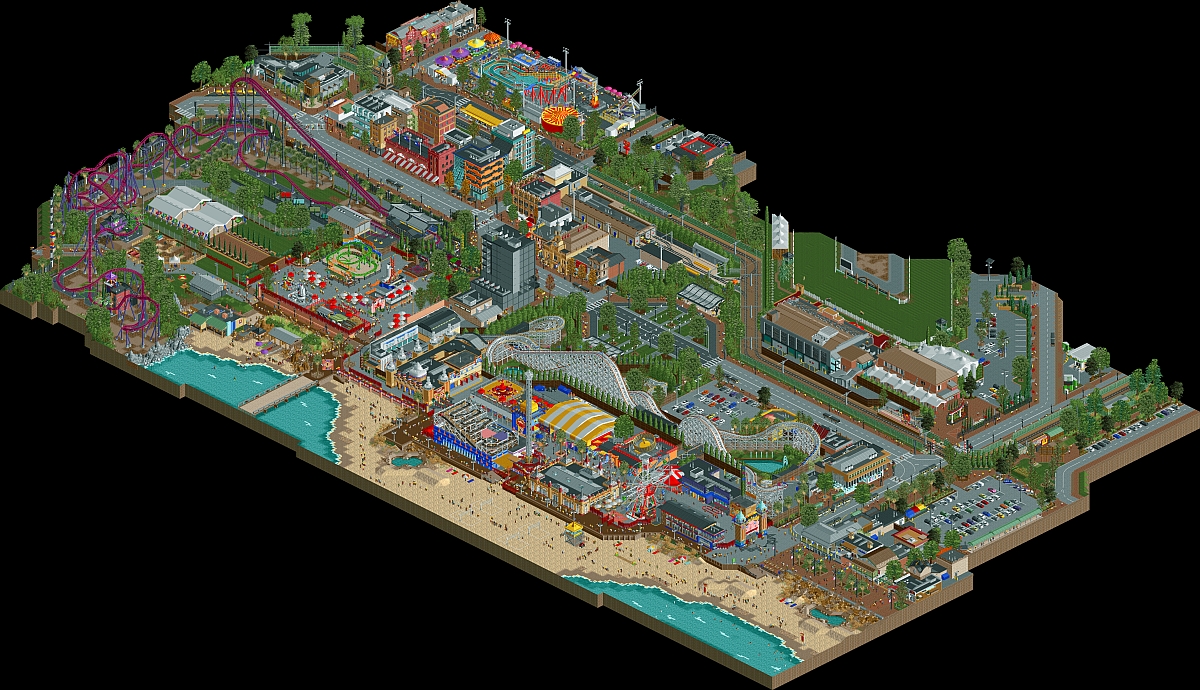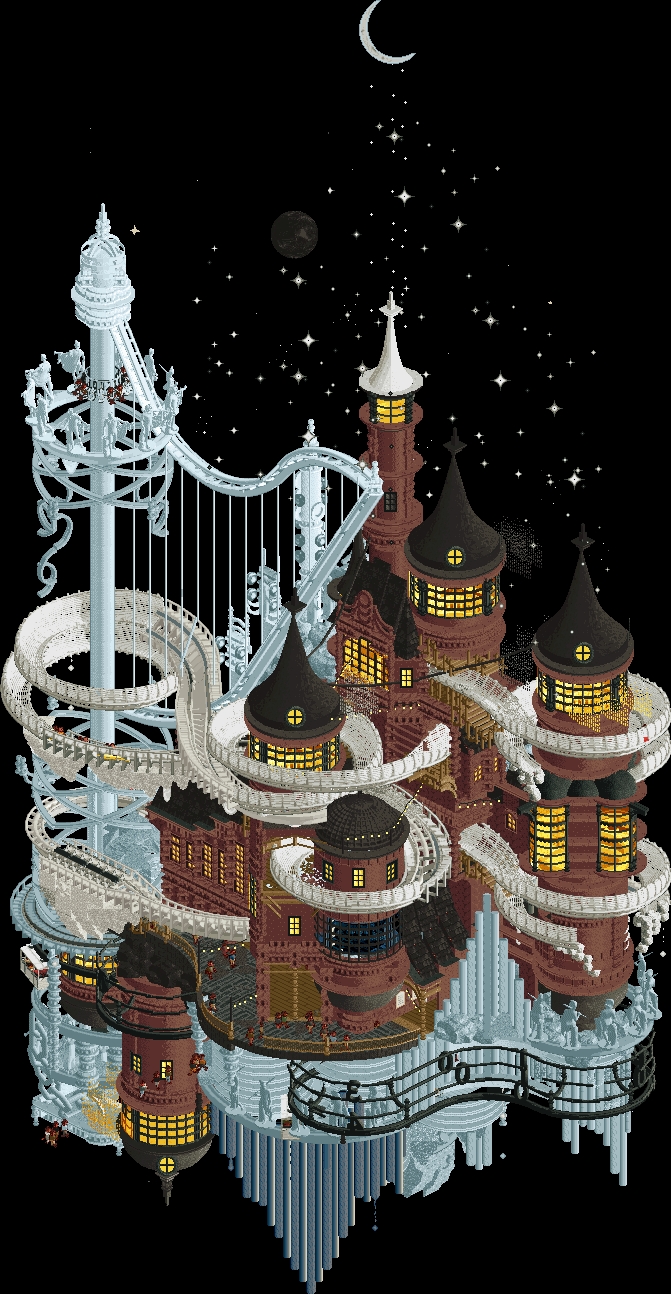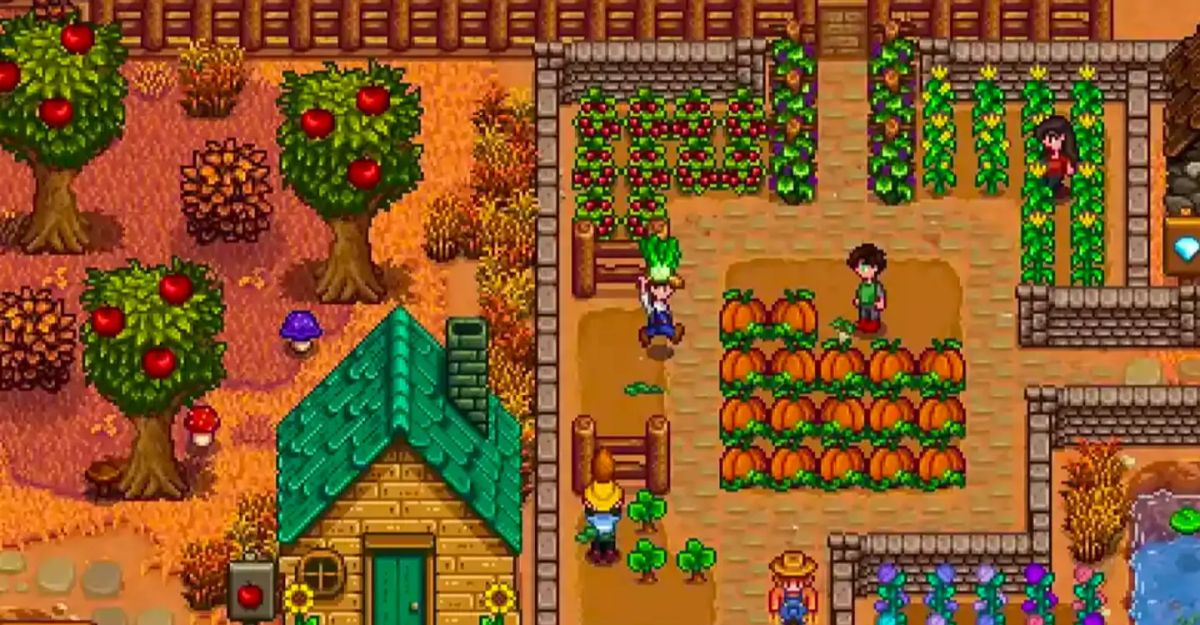‘How can you be a champion of rollercoaster tycoon? It’s not a competition!’ is something I get asked on a semi-regular basis. The theme park builder RollerCoaster Tycoon (RCT) was a runaway sensation back at the time of its release, in 1999. The original aim of the game was to complete various scenarios, such as having a certain number of guests in the park or a certain amount of money in the bank at the end of a few years of construction. And yes, you could make the rides blow up. Quickly, however, RCT grew into a sandbox tool, something more akin to a glorified architecture simulator. In much the same way that you can build large structures out of LEGO or Minecraft blocks, parks in Rollercoaster Tycoon are built up brick-by-brick and ride-by-ride, often to excruciating levels of detail.
Despite the proliferation of alternatives in the intervening two decades, there still exists a lasting—growing, even—internet community dedicated to the art form that is RCT ‘parkmaking,’ as it is referred to. Thousands of players every day spend a cumulative thousands of hours carefully crafting intricate theming for their roller coasters, log flumes, and ghost trains. A couple weeks ago, for example, I spent more than thirty hours constructing one small house on the American prairie filled with Eldritch horrors.
Of course, players around the world build in a wide variety of styles—from strict recreations of real theme parks, to realistic-but-imagined parks, to fantasy or sci-fi worlds and even full-blown abstract expressionism.

Luna Park Adelaide by Stoksy—a parkmaker from South Australia—is a partial recreation of the Luna Parks in both Sydney and Melbourne, transposed to his home city of Adelaide.
The oldest RCT community is New Element, an unofficial fanpage and old-school forum running almost continuously since 2002 with a particular emphasis on the minutiae of detailed theming and beautiful park composition. Every year, New Element runs a major competition, whose formats varies on a roughly three-year cycle. To decide the winners, parks are built in advance and then put to a public poll.
This year the competition format is ‘Micro Madness’—a 64-person March Madness-inspired knockout tournament, where players are tasked with building miniature parks for their matchups. with round parks due last Sunday. The competition through the semi-finals so far has been unprecedentedly intense, with controversial upsets and blossoming new stars (yours truly was unceremoniously dumped in the semis).
The odds-on favourite to win the whole thing is WhosLeon, a contemporary Dutch master known for dramatic, dreamlike architectural wonders (RCT remains extremely popular in the Netherlands, and local players share idiosyncratic styles and a common parkmaking history). In no particular order, Leon’s competition includes nin, a videogame artist known for their clean designs and immersive world-building; wheres_walto, whose moving-popup-book-style dioramas have been impossible to vote against; and wildcard AvanineCommuter, a real-life architect who indulges in massive, hedonistic fantasy worlds within the virtual reality of RollerCoaster Tycoon.

‘The Melting Orchestra,’ WhosLeon’s semi-finals entry for Micro Madness. A bobsled roller coaster weaves around fantasy-sized icy orchestral instruments, set into a softly glowing Eastern European-styled castle.
The RollerCoaster Tycoon community takes itself extremely seriously. Of course there is the necessary and endlessly entertaining r/hobbydrama—I could write thousands of words covering the explosive controversies of past competitions, personal feuds and the one time an admin had to drive down to Florida to ‘buy’ the rights to the website from the previous admin’s mum. But more than that, the community as a whole takes itself seriously as an artistic enterprise.
Indeed, the argument over what constitutes ‘art’ in RCT rages continuously in the Discord, for better or worse—I’m quite certain the most common descriptor leveled at New Element is ‘elitist’. Are we the arbiters of an extremely avant-garde artistic form? Or are we faithful nostalgists, obsessed mainly with the kitsch and commercialism of real-life theme parks?
The answer does not really matter, of course, except to ourselves. But the question of how to consider and critique the creative output of niche communities like New Element is endlessly fascinating. In a few keystrokes you can find entire communities devoted to: the creation of dazzling cryptic sudokus; elaborately themed Hot Wheels-esque race tracks in Trackmania; or Mario 64 ROMhacks which have decompiled and rebuilt the entire source code of the game to squeeze a few more frames-per-second out of their custom stages. There are just a lot of things being created out there, in mediums the majority of us have never even heard of.
This isn’t a new phenomenon, either, although the existence of the internet certainly broadens the horizon. I have always been attracted for instance to early animation. Toiling away in terrible conditions in the ’30s and ’40s, animators worked to perfect the subtleties of an artform that was not appreciated as an artform outside its community. Wile E Coyote is, of course, silly slapstick for children—but everytime I watch it, I find myself pausing every few seconds to admire the minimalist, mid-century styled desert scenes and the absurd but narratively compelling ‘rules’ of the universe it occupies.
Now, of course, you can study animation at university and read as much art theory as you like about cartoons. But those early years, where the most discerning audience of the animators was other animators, is really what I find myself dwelling on the most. Theme parks, like animation, are similarly just ‘silly slapstick for children.’ Yes, they both exist to make the mouse more money. Yet, as a somewhat experienced (virtual) parkmaker, I don’t doubt for one second that the Disney Imagineers care deeply about the craftsmanship of the rides they design. Besides, there are a few real-life theme park designers moonlighting in the RCT community.
I could sit here and try and persuade you of the ways in which ‘theme park design’ is a novel artform. But to some extent, the real beauty of this kind of work is that it doesn’t have an external audience. The visual arts, literature, film—people who don’t do them, still appreciate. Nobody else cares about RollerCoaster Tycoon, except the people who care about RollerCoaster Tycoon. There is a particularly pure joy to be found in such holistically creative collectives.
I’m not claiming that RCT, or theme park design in general, is due its ‘big break’ the same way film or animation or video game design eventually entered the academic discourse. But the way that niche artforms from niche communities frame the relationship between art and artist and audience is unique—we are forced to examine why we’re really doing these things (‘art’), and who we’re doing them for. The questions are existentially compelling.
As a writer, I spend too much time awake at night worrying about building an audience for my work. And yet, I spend even more time awake at night, planning my next RollerCoaster Tycoon park in my head, for an audience of the hundred-or-so RCT parkmakers I care about the most.
The RCT community takes itself very seriously—because it is serious. And also, it is kitsch, and niche, and tacky, and two decades dated, but I care about winning its competitions as much or more than I care about getting a book published. I’m barely even exaggerating.
There is something fundamental here about the capacity of humans to cope with ‘audience’. At the end of the day, it seems, all I really care about is doing art for our friends. It’s good to be reminded of that sometimes, when the writing rejections pile up and the angst of future careers sets in. Maybe we should all choose an incredibly random video game from 1999, or any strangely niche hobby or group of weird people and jump into their Discord. There’s a lot of art out there to do.

‘The Koi Pond,’ by Xtreme97 for the first round of Micro Madness 2023, might best be described as ‘Japanese magical realism.’
On Sunday, WhosLeon, nin, wheres_walto and AvanineCommuter sent in their finals entries for Micro Madness 2023. They had been presumably working on these miniature parks for about four weeks now, in the small hours of the night after work or at their desk over lunch.
If you remember how old internet forums work and feel like checking out the Micro Madness parks—which I obviously highly recommend—there’s a link to the Discord in the bottom margins of the New Element homepage. Someone will absolutely help you install the game. Tell them Cocoa sent you.



